Radar Design
Principles
Signal Processing and the Environment
Fred E. Nathanson
Georgia Tech Research lnstitute
Rockville, Maryland
with
J. Patrick Reilly
The Johns Hopkins University
Applied Physics Laboratory
Laurel, Maryland
Marvin N. Cohen
Georgia Tech Research lnstitute
Georgia lnstitute of Technology
Atlanta, Georgia
Second Edition
s c ; 3
PUBLISHING, IRC.
MENDHAM, NEW JERSEY
~
�
This is a reprinting of the 199 1 edition
originally published by McGraw-Hill, Inc.
0 1999 by Marvin N. Cohen, Allan J. Nathanson, Lila H. Nathanson,
Janice N. Smith, J. Patrick Reilly
0 1991, 1969 by McGmw-Hill, Inc.
All rights reserved. No part of this book may be reproduced
or used in any form whatsoever without written permission from
the publisher. For information, contact the publisher,
SciTech Publishing, Inc., 89 Dean Road, Mendham, NJ 07945
Printed in the United States of America
10 9 8 7 6 5 4 3 2 1
ISBN 1-891 121-09-X
SciTech books may be purchased at quantity discounts for educational,
business, or sales promotional use. For information, contact the publisher:
SciTech Publishing, Inc.
89 Dean Road
Mendham, NJ 07945
e-mail: scitech@worldnet.att.net
www. scitechpub .com
IEEE members may order directly from the association.
The Institute of Electrical and Electronics Engineers, Inc.
PO Box 133 1,445 Hoes Lane
Piscataway, NJ 08855-1331 USA
e-mail : customer. service@ieee . org
www.ieee .org
IEEE Order No.: PC5822
�
Acknowledgments
The dramatic advances in radar systems and especially in radar signal
processing are the result of the efforts of many individuals in many
fields. To help me assimilate this information, I enlisted the aid of a
number of knowledgeable coworkers in the radar field.
The primary credit goes to J. Patrick Reilly of the Johns Hopkins
University, Applied Physics Laboratory, for both the original book and
this edition. He authored Chap. 9 and significant portions of Chap. 1,
2,3,5,6, and 7. Dr. Marvin Cohen of Georgia Tech Research Institute
(GTRI) contributed a new version of Chap. 12 and contributed to the
rewrite of Chap. 13.
I thank Dr. Mark Richards (GTRI) who contributed the new section
on pulse Doppler signal processor architecture; Me1 Belcher (GTRI) for
the CFAR section in Chap. 4; A. Corbeil, J. DiDomizio, and R. DiDomizio
of Technology Service Corporation, Trumbull, Connecticut for the new
material on track before detect in Chap. 4; and Allen Sinsky of Allied-
Signal for updating the ambiguity function material in Chap. 8.
I remain indebted to those at the Applied Physics Laboratory who
assisted with the first edition, and to my colleagues during 18 years
at Technology Service Corporation where much of the new material
evolved from various programs and short courses.
I wish to thank Drs. E. K. Reedy, J. L. Eaves, and Jim Wiltse of
Georgia Tech Research Institute for their encouragement and support
in preparing this edition.
I greatly appreciate the assistance of Janice Letow for typing,
assembling, and keeping the manuscript on track.
My final thanks to the patience and understanding of my wife, Lila,
who supported me while I underestimated the effort of a new edition.
Finally, thanks to my daughter and son-in-law, and to my son who
expected me to build him a radar 20 years ago. I still do not know if I
will ever get to build him one.
xiii
�
McGraw-Hill Reference Books of Interest
Handbooks
Standard Handbook for Mechanical Engineers
Standard Handbook for Electrical Engineers
AVALONE AND BAUMEISTER
COOMBS Basic Electronic Instrument Handbook
COOMBS Printed Circuits Handbook
CROFT AND SUMMERS American Electricians’ Handbook
DI GIACOMO Digital Bus Handbook
DI GIACOMO VLSI Handbook
FINK AND BEATY
FINK AND CHRISTIANSEN Electronics Engineers’ Handbook
Standard Handbook of Engineering Calculations
HICKS
INGLIS Electronic Communications Handbook
JOHNSON AND JASIK Antenna Engineering Handbook
JURAN Quality Control Handbook
KAUFMAN AND SEIDMAN Handbook for Electronics Engineering Technicians
KAUFMAN AND SEIDMAN Handbook of Electronics Calculations
KURT2 Handbook of Engineering Economics
SKOLNIK Radar Handbook
STOUT AND KAUFMAN Handbook of Microcircuit Design and Application
STOUT AND KAUFMAN Handbook of Operational Amplifier Design
Turn Engineering Mathematics Handbook
W l L L I m s Designer’s Handbook of Integrated Circuits
WILLIAMS AND TAYLOR Electronic Filter Design Handbook
Dictionaries
Dictionary of Computers
Dictionary of Electrical and Electronic Engineering
Dictionary of Engineering
Dictionary of Scientific and Technical Terms
MARKUS Electronics Dictionary
Other Books
BOITHIAS Radiowave Propagation
GKiwirm- z rKci7owaue Arnpfcflers ana‘ Usciliiaators
JOHNSON AND JASIK Antenna Applications Reference Guide
MILLICAN Modern Antenna Design
SKOLNIK
Introduction to Radar Systems
�
ABOUT THE AUTHOR
A specialist in radar search techniques, radar systems,
radar signal processing, and electro-optical devices, Fred E.
Nathanson has supervised laboratory and prototype search
and radar development and served with numerous
evaluation and advisory groups. He is currently Principal
Research Engineer with Georgia Tech Research Institute
in Rockville, Maryland. Mr. Nathanson holds a B.E. in
Electrical Engineering from John Hopkins University, and
an M.S. from Columbia. A Fellow of the IEEE “for
contributions to radar systems” and a member of the Radar
Systems Panel, he has published many technical articles
and taught intensive short courses worldwide.
�
Preface
The first version of this book was written in the late 1960s. At that
time the relationships between the radar waveform, the carrier
frequency, the signal processing, and the environment were understood
well enough to project some highly capable systems. The digital age
was just beginning, but implementation was still cumbersome and
expensive. During the late 1970s and early 1980s a number of
sophisticated but highly successful radars were developed using the
knowledge of the environment to select the waveforms and taking
advantage of the rapid progress in digital technology.
As the 1980s evolved, radar was beginning to be called a mature
technology until the Exocet missile, “stealth targets, sophisticated
electronic countersurveillance measures (ECM), drug interdiction
requirements, etc., demanded a new look at radar design and
technology. This in turn requires further knowledge of the details of
target reflectivity, natural clutter and clutter artifacts, and a radar’s
susceptibility to electronic interference. The potential of remote sensing
and space-based radars also requires a better understanding of the
environment and signal processing.
Thus the emphasis of this book is on radar design to cope with the
“total environment” rather than any single performance goal. The total
enuzronrnent, as defined here, includes the unwanted reflections from
the sea, land areas, precipitation, and chaff, as well as thermal noise
and jamming. It also recognizes that mapping, weather sensing, terrain
avoidance, altimetry, etc., may be designed for a single-function radar
or as modes of a multifunction radar.
As in the first edition, the book is divided into three parts. The first
four chapters contain an introduction to radar; expanded material on
the fundamentals of antennas, transmitters, multipath and ducting
problems; and a review of the radar equations for the detection of
targets in the presence of noise and natural and man-made interference.
This is followed by descriptions of the statistics of target detection and
the techniques for obtaining automatic detection with considerable new
material on advanced constant false alarm techniques and track-
before-detect.
xi
�
xii
Preface
Chapter 5 contains a mostly new and thorough survey and analysis
of the available material on the reflectivity of both natural and man-
made targets. It includes the spectral, polarization, and wavelength
properties since they all have been shown to have a substantial effect
on the choice of processing technique. Chapter 6 contains greatly
expanded material on propagation and
the reflectivity from
precipitation and chaff. This includes statistics on their occurrence,
carrier-frequency selection, and frequency-agility effects, wind shear
phenomena, the bright band, anomalous echoes, etc. with statistical
descriptors to evaluate signal-processing techniques. Chapter 7 follows
in the same format to describe sea and land clutter with new models,
and statistical descriptions that must be included when analyzing high-
resolution radar detection of low-flying targets. Reflectivity is related
to carrier frequency, polarization, and ducting effects. Bistatic data are
included.
Chapters 8 through 13 contain descriptions of the various signal-
processing techniques that are widely used or proposed for future radar
systems. After a general discussion of processing concepts, specific
techniques are discussed for the detection of moving targets by use of
the Doppler effect (CW, MTI, pulse Doppler), FFTs, and fast convolvers
and the pulse compression techniques (phase-coding, frequency-coding,
and linear FM). In most of these signal-processing chapters there is a
discussion of the theory of operation, and diagrams of typical processors
with emphasis on the new digital implementations and the limitations
and losses. The equations for performance evaluation, along with
advantages and disadvantages of each technique, are generally
included.
Chapter 14 describes some newer or more specialized techniques
such as the moving target detector (MTD) and clutter maps; ground,
airborne, and space-based meteorological radars often using pulse-pair
processors; and surveillance radars on aerostats. The final section
contains a description on how to analyze or simulate coherent radars
including the limitations and related loss terms.
It is not suggested that there is an optimum radar or even a generally
optimum waveform, but that in the impending era of adaptive radar,
the radar will sense the environment and adapt to this information.
While not specifically written as a textbook, the earlier edition was
used for a number of graduate courses on radar and in many intensive
short courses. An attempt has been made to better organize the
material, while retaining the chapter structure for those familiar with
the first edition. Supplementary material and further derivations are
available in the 800 references.
Fred E. Nathanson
�
Contents
Preface
Acknowledgments
xi
xiii
Chapter 1. Radar and Its Composite Environment
F. E. Nathanson and J. P. Reilly
1.1 Radar Functions and Applications
1.2 Evolution of Radar Signal Processing
1.3 Radar and the Radar Equation
1.4 Functions of Various Types of Radar
1.5 Target-Detection Radars for Aircraft, Missiles, and Satellites
1.6 Radar Frequency Bands and Carrier Selection
1.7 Surface and Low-Altitude Target Detection
1.8 Criteria for Choice of Signal-Processing Techniques
1.9 Antenna and Array Considerations
1.10 Transmitters
1.11
Radar Grazing Angle for Refractive Conditions-?4 Earth
Approximation
1.12 Forward-Scatter Effects
Chapter 2. Review of Radar Range Performance Computations
F. E. Nathanson and J. P. Reilly
2.1 General Radar Range Equation
2.2 Radar Detection with Noise Jamming or Interference
2.3 Beacon and Repeater Equations
2.4 Bistatic Radar
2.5 Radar Detection Equations in Distributed Clutter (Volume Reflectors)
for Pulse Radars
2.6 Pulse-Radar Detection Equations for Area Clutter
1
1
3
5
9
11
17
21
24
26
31
33
41
49
49
60
64
65
67
71
V
�

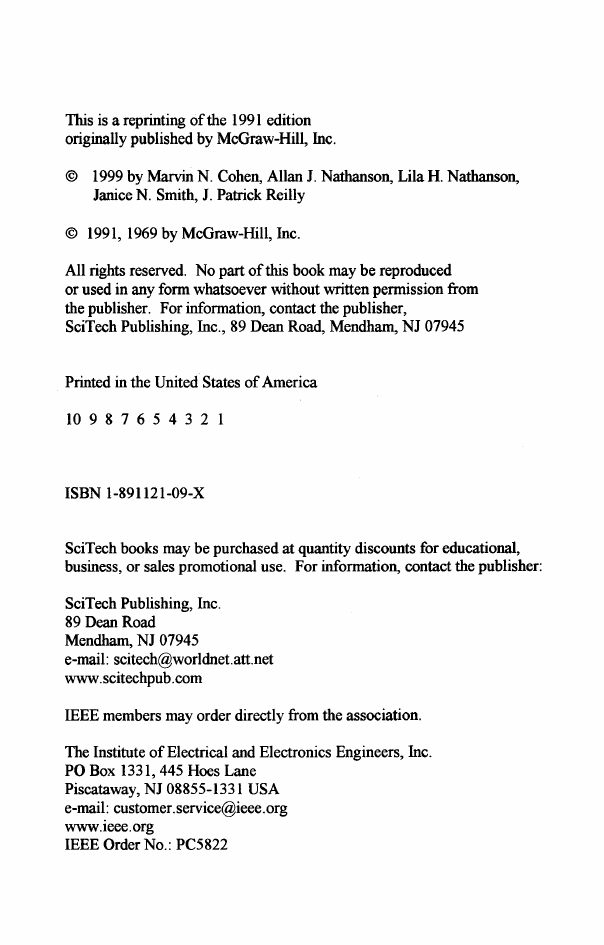
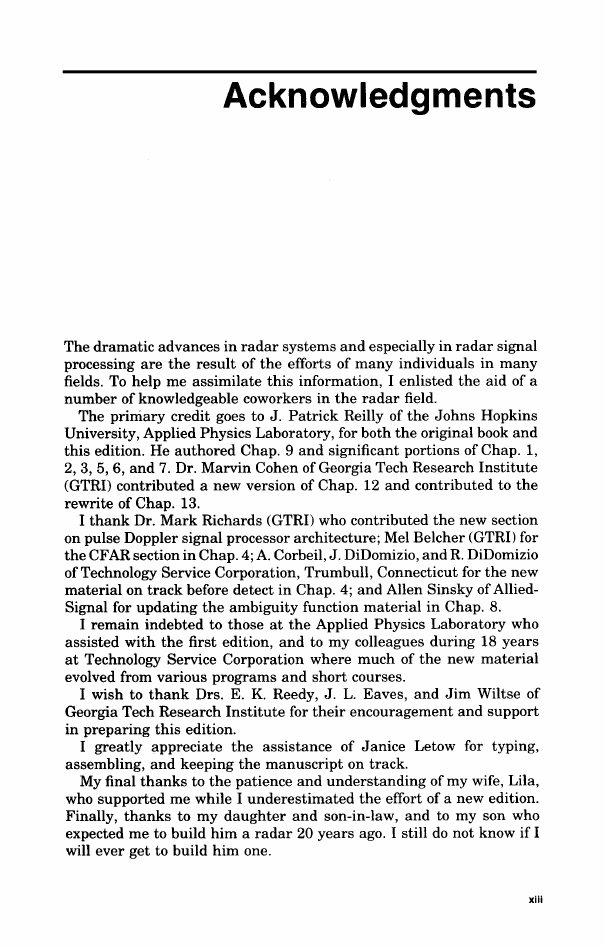
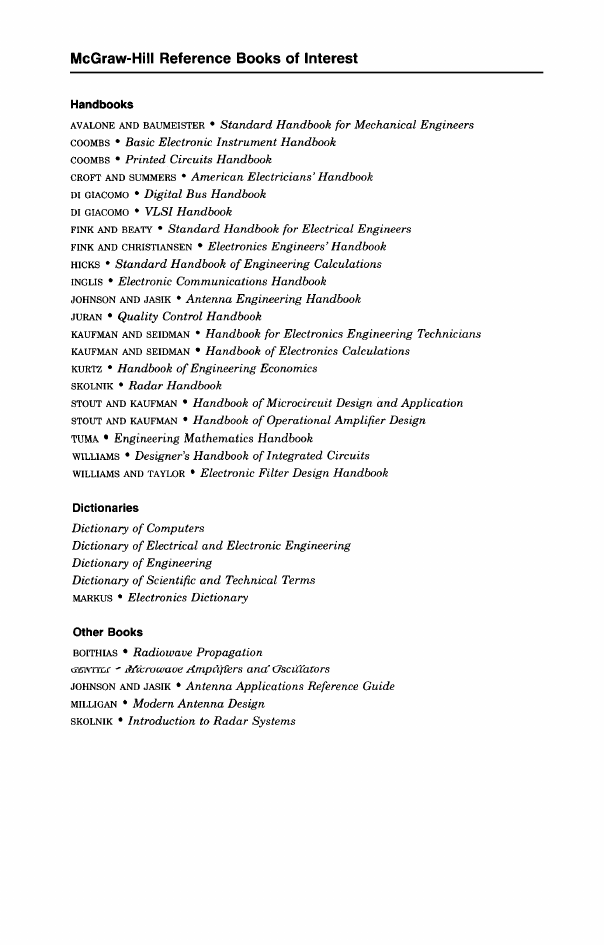
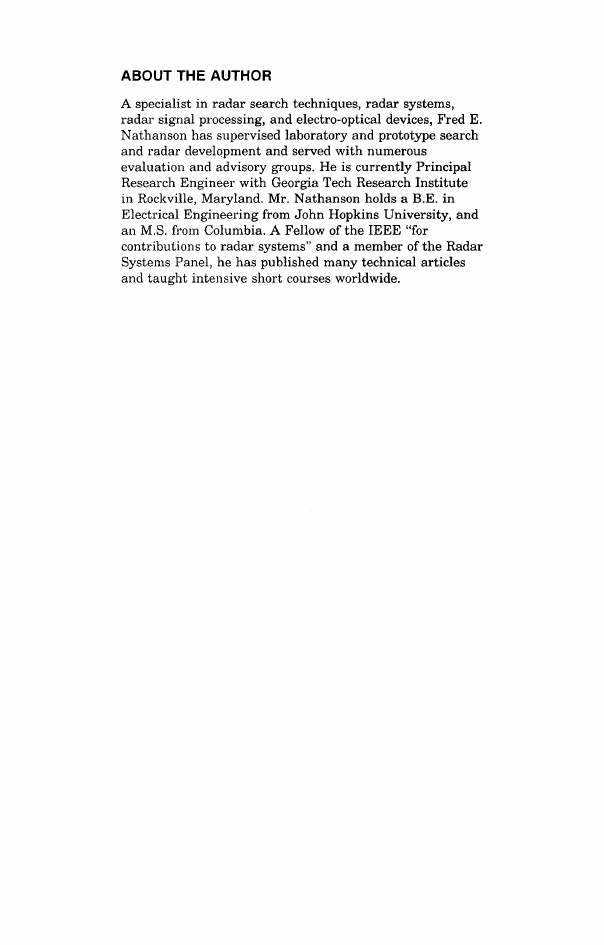
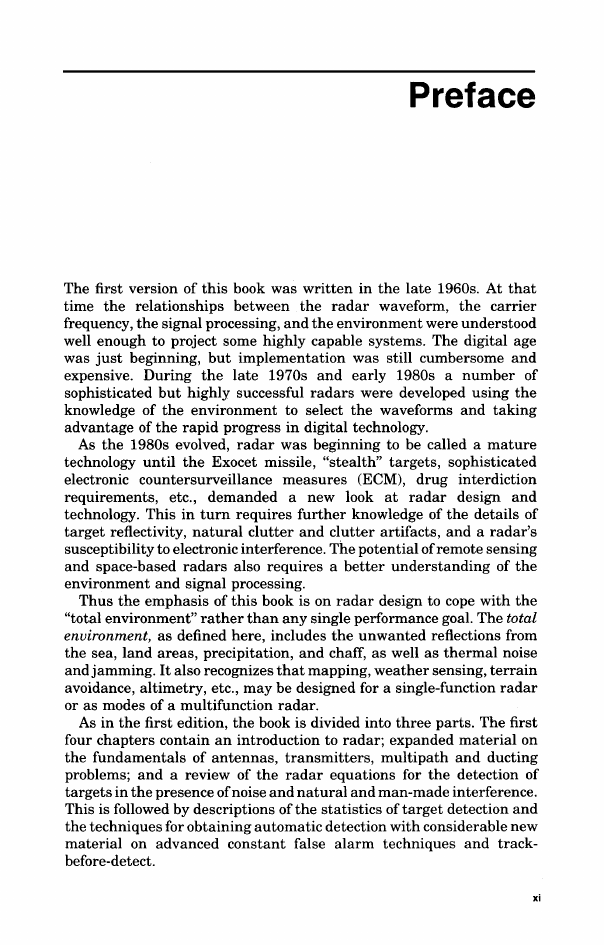
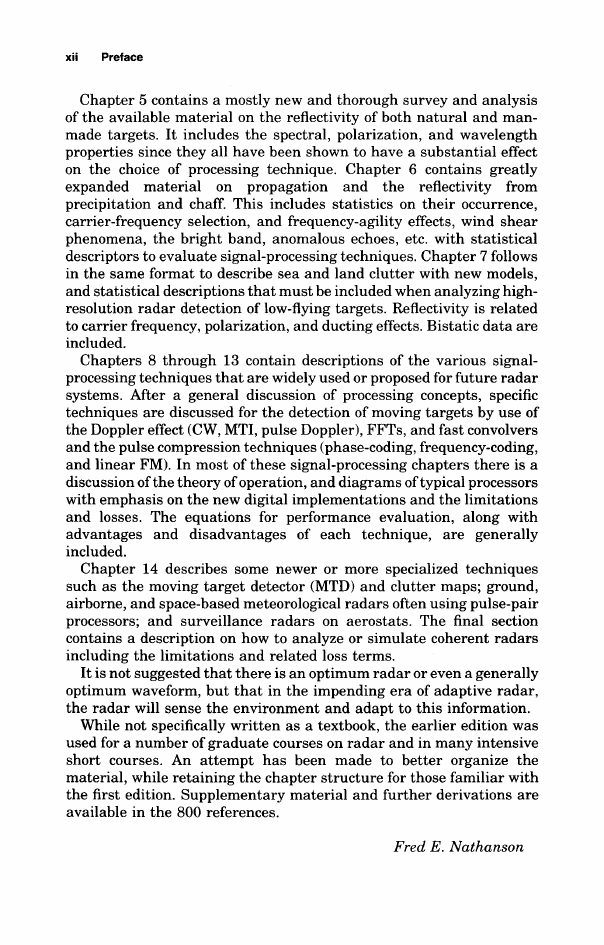
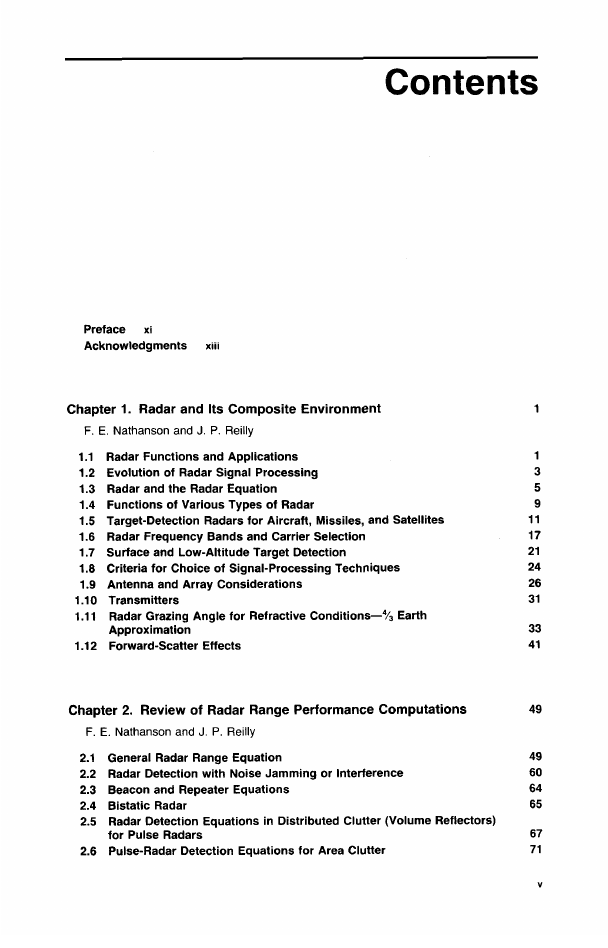








 2023年江西萍乡中考道德与法治真题及答案.doc
2023年江西萍乡中考道德与法治真题及答案.doc 2012年重庆南川中考生物真题及答案.doc
2012年重庆南川中考生物真题及答案.doc 2013年江西师范大学地理学综合及文艺理论基础考研真题.doc
2013年江西师范大学地理学综合及文艺理论基础考研真题.doc 2020年四川甘孜小升初语文真题及答案I卷.doc
2020年四川甘孜小升初语文真题及答案I卷.doc 2020年注册岩土工程师专业基础考试真题及答案.doc
2020年注册岩土工程师专业基础考试真题及答案.doc 2023-2024学年福建省厦门市九年级上学期数学月考试题及答案.doc
2023-2024学年福建省厦门市九年级上学期数学月考试题及答案.doc 2021-2022学年辽宁省沈阳市大东区九年级上学期语文期末试题及答案.doc
2021-2022学年辽宁省沈阳市大东区九年级上学期语文期末试题及答案.doc 2022-2023学年北京东城区初三第一学期物理期末试卷及答案.doc
2022-2023学年北京东城区初三第一学期物理期末试卷及答案.doc 2018上半年江西教师资格初中地理学科知识与教学能力真题及答案.doc
2018上半年江西教师资格初中地理学科知识与教学能力真题及答案.doc 2012年河北国家公务员申论考试真题及答案-省级.doc
2012年河北国家公务员申论考试真题及答案-省级.doc 2020-2021学年江苏省扬州市江都区邵樊片九年级上学期数学第一次质量检测试题及答案.doc
2020-2021学年江苏省扬州市江都区邵樊片九年级上学期数学第一次质量检测试题及答案.doc 2022下半年黑龙江教师资格证中学综合素质真题及答案.doc
2022下半年黑龙江教师资格证中学综合素质真题及答案.doc